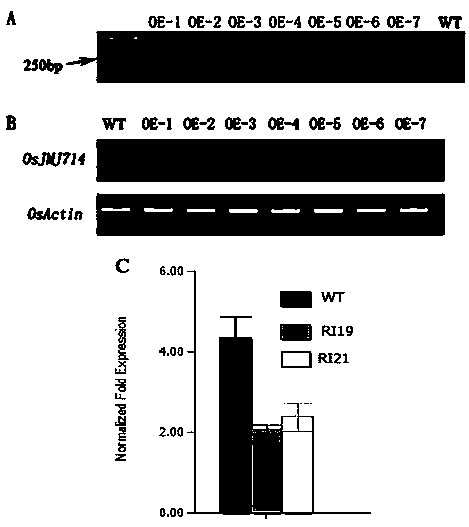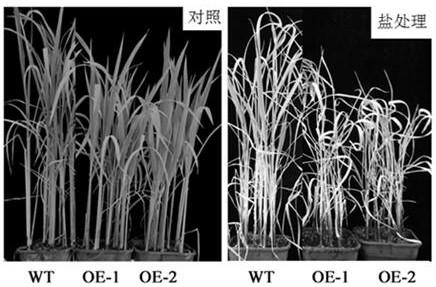The function and application of osjmj714 affecting rice grain size and salt stress tolerance
A technology of JMJ714, rice grain, applied in the direction of application, introduction of foreign genetic material and enzymes using vectors, etc., can solve the problem that the impact of research on crop yield is poorly understood.
- Summary
- Abstract
- Description
- Claims
- Application Information
AI Technical Summary
Problems solved by technology
Method used
Image
Examples
Embodiment 1
[0018] Example 1: Creation and identification of transgenic rice materials
[0019] 1. Construction of OsJMJ714 gene recombinant plant expression vector
[0020] Using the coding region sequence of OsJMJ714 (gene number: Os09g0483600) as a template, OsJMJ714-F 5'-AGTGGATCCATGGAGCGCGCAGTGCGGGA-3' and OsJMJ714-R 5'-GGCGGTACCTCAATCATTCGTCTCCTCGA-3' were designed by bioinformatics analysis. The 1080bp full-length coding region sequence fragment of OsJMJ714 was amplified by PCR from the cDNA library, and the PCR fragment and the plant expression vector pCAMBIA1205 were digested with BamHI and KpnI, then ligated and transformed into E. coli DH5α, and positive clones were picked Identification and sequencing analysis were carried out to obtain the recombinant plant expression vector pCAMBIA1205-JMJ714 inserted into the OsJMJ714 gene and in the correct reading frame, which was introduced into Agrobacterium AGLO.
[0021] Creation of rice material to knock out OsEAR factor in rice usi...
Embodiment 2
[0035] Example 2: JMJ714 affects rice grain size
[0036] Rice grain size is closely related to its yield and quality traits. We found that rice grains overexpressed JMJ714 became smaller, as figure 2 As shown, compared with wild-type seeds, JMJ714-overexpressed transgenic rice seeds became smaller, including reduced seed length and width compared with wild-type seeds; 50 mature seeds were further selected for statistical analysis of grain size, wild The average length of the grains of the two transgenic lines was 0.7 cm, 0.61 cm and 0.60 cm; the width of each grain of the wild type was 0.332 cm, and that of the two transgenic lines were 0.294 cm and 0.289 cm respectively. These results indicated that the gene It is involved in the regulation of rice grain size, and its overexpression leads to smaller rice seeds and affects rice yield; while the seeds of transgenic rice with silenced expression of this gene become larger, indicating that reducing the expression of this gene ...
Embodiment 3
[0037] Example 3: Overexpression of OsJMJ714 reduces the salt tolerance of rice
[0038] We treated 3-week-old WT and JMJ714-overexpressed transgenic rice materials with 1% NaCl for 8 days, then removed the saline, and resumed culture in water for 7 days. The results were as follows: image 3 As shown, almost all the transgenic rice plants with JMJ714 overexpression died, while some (about 35%) of WT survived, but most of the transgenic rice plants (about 60%) with the gene silenced survived, indicating that JMJ714 overexpressed Expression results in reduced tolerance of rice to salt stress, and reduced expression of this gene can increase the salt tolerance of transgenic rice.
[0039] Institute of Biotechnology, Chinese Academy of Agricultural Sciences
[0040] The function of OsJMJ714 affecting rice grain size and salt stress tolerance and its application
[0041] 2
[0042] 1
[0043] 1080
[0044] DNA
[0045] 1
[0046] 1 ATGGAGCGCG CAGTGCGGGA GCTGTGGGCG GAGTC...
PUM
| Property | Measurement | Unit |
|---|---|---|
| length | aaaaa | aaaaa |
Abstract
Description
Claims
Application Information
 Login to View More
Login to View More - R&D
- Intellectual Property
- Life Sciences
- Materials
- Tech Scout
- Unparalleled Data Quality
- Higher Quality Content
- 60% Fewer Hallucinations
Browse by: Latest US Patents, China's latest patents, Technical Efficacy Thesaurus, Application Domain, Technology Topic, Popular Technical Reports.
© 2025 PatSnap. All rights reserved.Legal|Privacy policy|Modern Slavery Act Transparency Statement|Sitemap|About US| Contact US: help@patsnap.com



